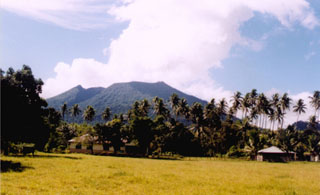Report on Ibu (Indonesia) — December 2023
Bulletin of the Global Volcanism Network, vol. 48, no. 12 (December 2023)
Managing Editor: Edward Venzke.
Research and preparation by Berger.
Ibu (Indonesia) Eruption continued during June-November 2023, with persistent ash explosions and thermal anomalies
Please cite this report as:
Global Volcanism Program, 2023. Report on Ibu (Indonesia) (Venzke, E., ed.). Bulletin of the Global Volcanism Network, 48:12. Smithsonian Institution.
Ibu
Indonesia
1.488°N, 127.63°E; summit elev. 1325 m
All times are local (unless otherwise noted)
The current eruption period of Ibu, a stratovolcano on Indonesia’s Halmahera Island, began in April 2008 and has primarily consisted of ash plumes and emissions varying from intermittent to daily, along with occasional thermal anomalies (BGVN 43:12, 48:06). This report updates activity through November 2023, based on daily reports from MAGMA Indonesia, advisories issued by the Pusat Vulkanologi dan Mitigasi Bencana Geologi (PVMBG, also known as Indonesian Center for Volcanology and Geological Hazard Mitigation, CVGHM), the Darwin Volcanic Ash Advisory Centre (VAAC), and various satellite data. MAGMA Indonesia is a platform developed by PVMBG to improve timely public access to volcano and earthquake activity.
According to PVMBG, from June to November 2023 daily gray-and-white plumes of variable densities usually rose 200-1,000 m above the nested summit craters and drifted in multiple directions. Occasional larger explosions prompted PVMBG to issue 50 Volcano Observatory Notice for Aviation (VONA) ash plume alerts during the reporting period. VONAs were issued every month, ranging from 5 in June to 14 in October; all described the ash plumes as dense. A few plumes rose as high as 1,500 meters during August-November. Clear Sentinel-2 satellite views showed ash plumes on 8 and 13 August, but webcam images showed intermittent ash plumes similar to those seen in recent years.
The MIROVA satellite volcano hotspot detection system recorded frequent thermal anomalies of low to moderate power throughout the reporting period. Data from imaging spectroradiometers aboard NASA’s Aqua and Terra satellites and processed using the MODVOLC algorithm (MODIS-MODVOLC) recorded hotspots on 6 June, 3 August, 30 September, five days in October (5, 10, 15, 26, 31), and four days in November (5, 12, 13, 26). Sentinel-2 satellite images showed a summit crater hotspot in every clear view, along with thermal anomalies extending S from the crater in a partially obscured view on 21 November. White-to-grayish emissions were also visible on clear days.
Geological Summary. The truncated summit of Gunung Ibu stratovolcano along the NW coast of Halmahera Island has large nested summit craters. The inner crater, 1 km wide and 400 m deep, has contained several small crater lakes. The 1.2-km-wide outer crater is breached on the N, creating a steep-walled valley. A large cone grew ENE of the summit, and a smaller one to the WSW has fed a lava flow down the W flank. A group of maars is located below the N and W flanks. The first observed and recorded eruption was a small explosion from the summit crater in 1911. Eruptive activity began again in December 1998, producing a lava dome that eventually covered much of the floor of the inner summit crater along with ongoing explosive ash emissions.
Information Contacts: Pusat Vulkanologi dan Mitigasi Bencana Geologi (PVMBG, also known as Indonesian Center for Volcanology and Geological Hazard Mitigation, CVGHM), Jalan Diponegoro 57, Bandung 40122, Indonesia (URL: http://www.vsi.esdm.go.id/); MAGMA Indonesia (Multiplatform Application for Geohazard Mitigation and Assessment in Indonesia), Kementerian Energi dan Sumber Daya Mineral (URL: https://magma.esdm.go.id/v1); Darwin Volcanic Ash Advisory Centre (VAAC), Bureau of Meteorology, Northern Territory Regional Office, PO Box 40050, Casuarina, NT 0811, Australia (URL: http://www.bom.gov.au/info/vaac/); Copernicus Browser, Copernicus Data Space Ecosystem, European Space Agency (URL: https://dataspace.copernicus.eu/browser/); MIROVA (Middle InfraRed Observation of Volcanic Activity), a collaborative project between the Universities of Turin and Florence (Italy) supported by the Centre for Volcanic Risk of the Italian Civil Protection Department (URL: http://www.mirovaweb.it/); Hawai'i Institute of Geophysics and Planetology (HIGP) - MODVOLC Thermal Alerts System, School of Ocean and Earth Science and Technology (SOEST), Univ. of Hawai'i, 2525 Correa Road, Honolulu, HI 96822, USA (URL: http://modis.higp.hawaii.edu/).

